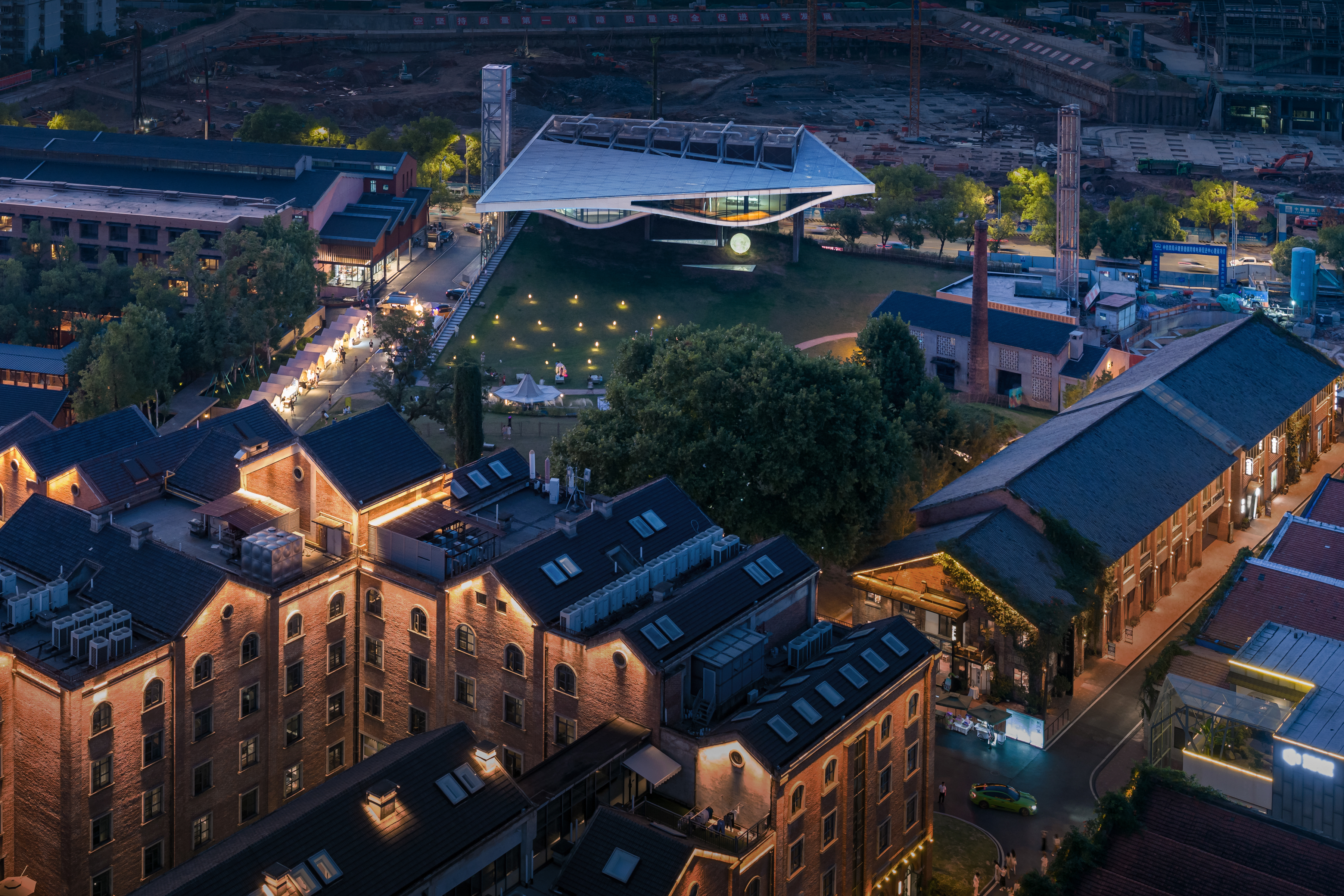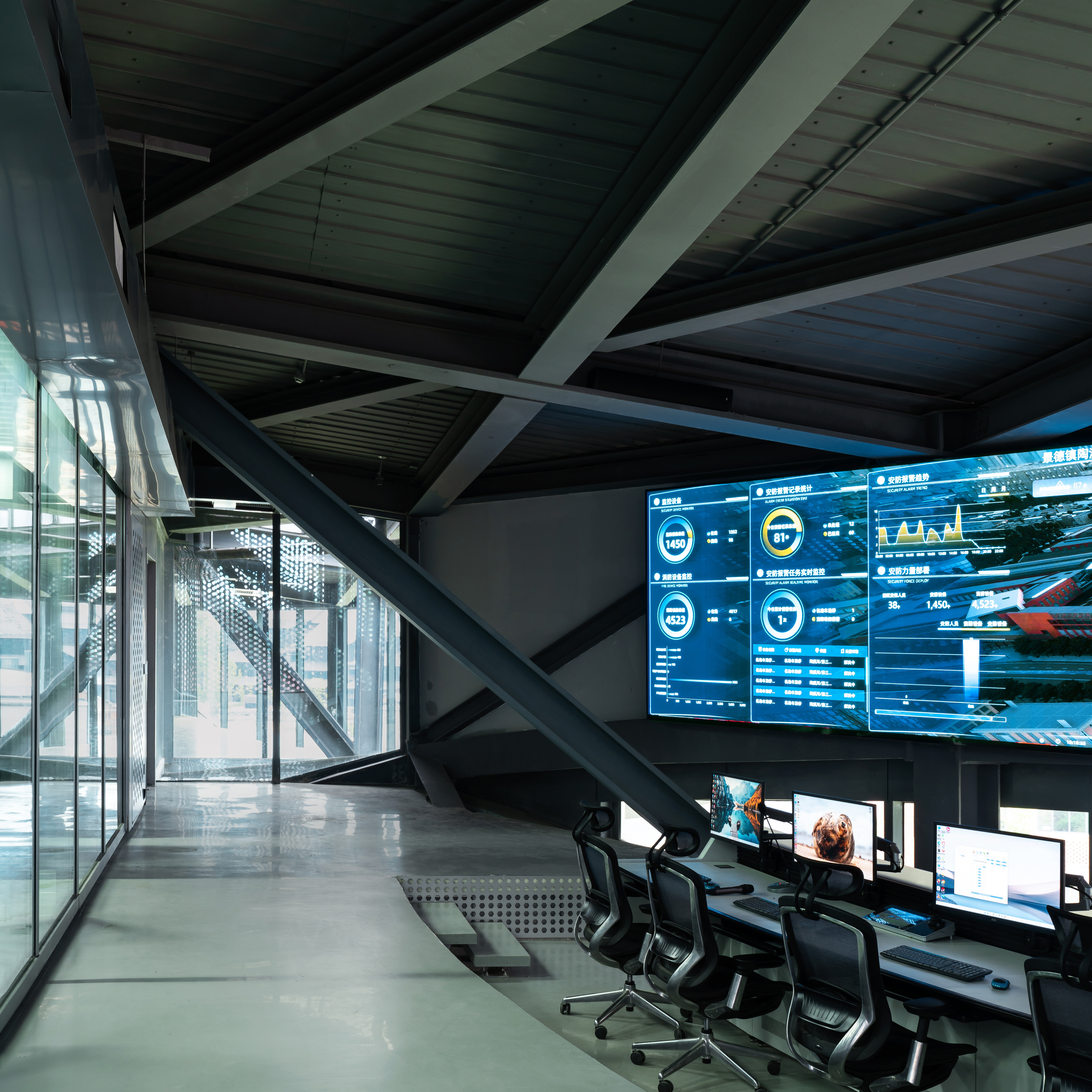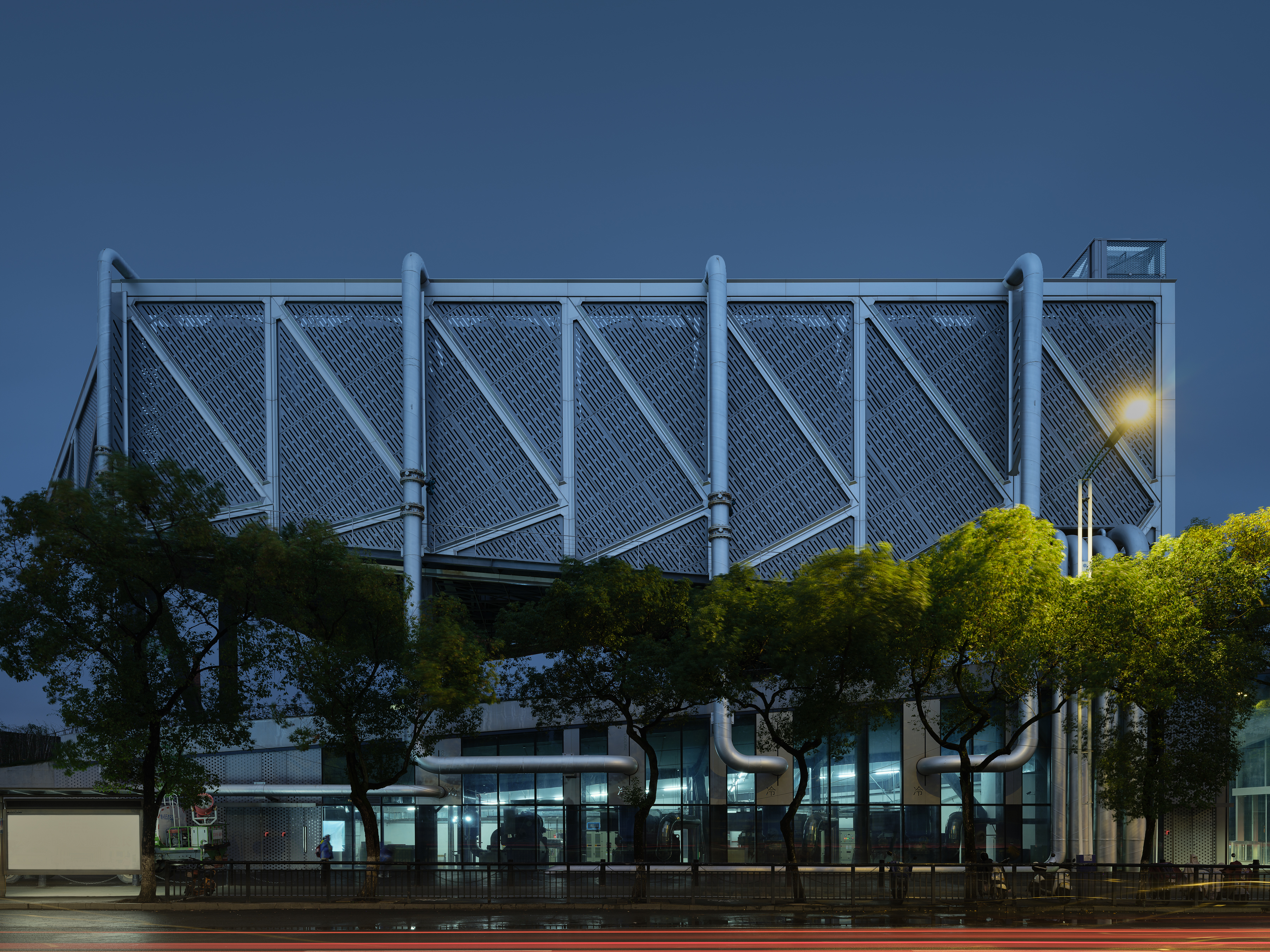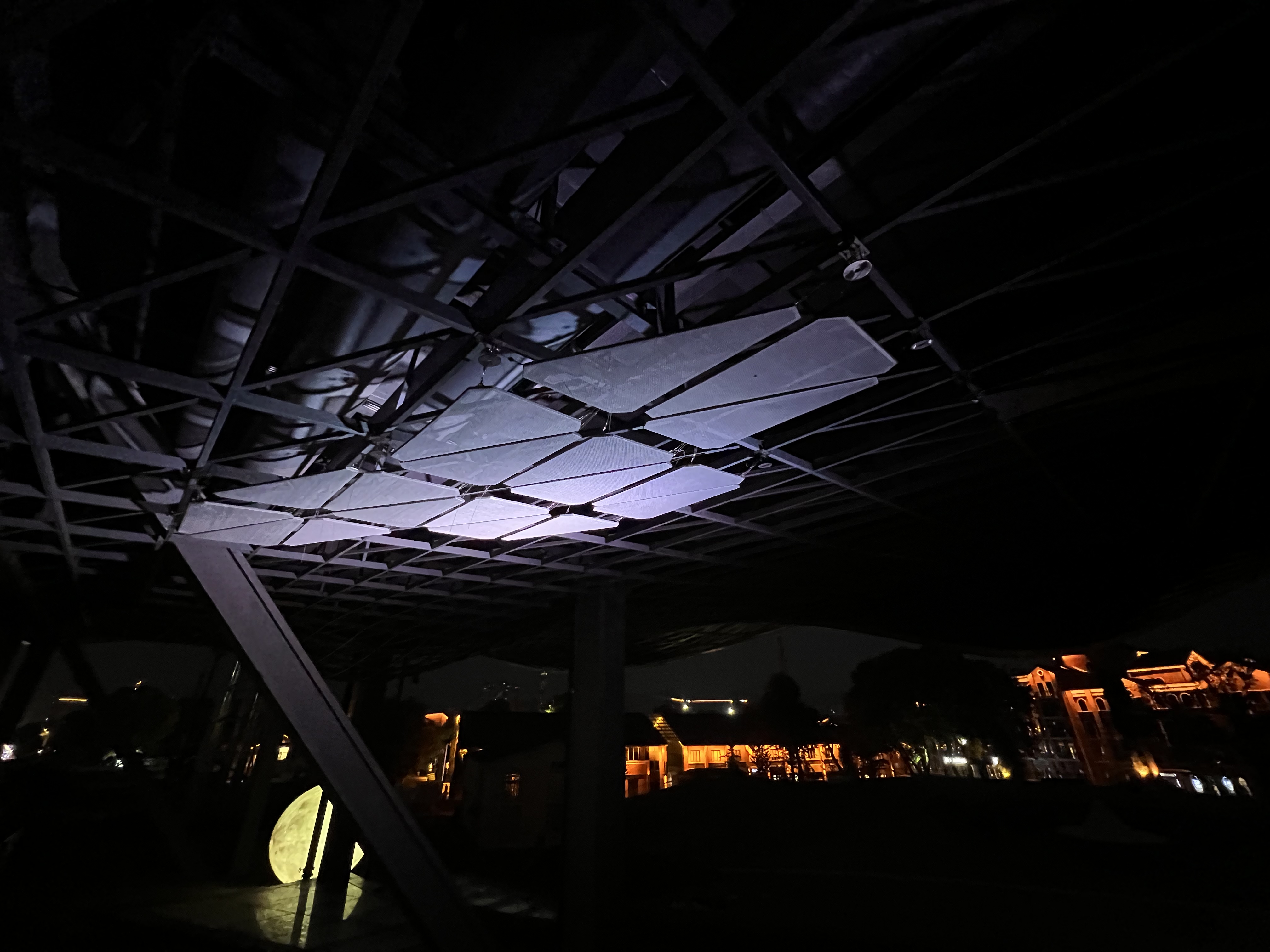

建筑/室内方案设计 行之建筑设计事务所
EPC总包单位 中国中元国际工程有限公司
项目地址 江西省景德镇
完成年份 2024年
建筑面积 5300平方米
撰文 熊星
“一个绿地公园中的设备用房,可以做成什么样?”
“What could a utility building in a green park look like?”
2019年夏天,蝉鸣怒响中,我被问到了这个有趣的问题。提问的人是景德镇陶溪川文创园区的业主,陶文旅的刘子力董事长。2012年他邀请清华大学张杰教授团队主持陶溪川保护更新利用的规划。
In the noisy summer of 2019 with cicadas chirping, I was asked this intriguing question. The inquisitor was Mr. Liu Zili, Chairman of Taowenlv, owner of the Jingdezhen Ceramic Art Ave Taoxichuan. Since 2012, he invited Professor Zhang Jie’s team from Tsinghua University to lead the preservation and renovation planning.
陶溪川的前身是国营宇宙陶瓷厂和陶瓷机械厂,如今它已经成为国家级文化产业示范园区、国家双创示范基地、国家级夜间文化和旅游消费集聚区、全国非遗旅游街区,这里是很多“景漂”艺术家和创作者的舞台。
Once the state-owned Cosmos Ceramics Factory and Ceramic Machinery Factory, Taoxichuan has since transformed into a national cultural industry and innovative entrepreneurship model zone, a nighttime tourist destination, and a street packed with intangible cultural heritage. It serves as a stage for many artists and creators who have migrated to Jingdezhen.



2019年的陶溪川,一期刚刚呈现,其他区域还没有成形,现有建筑也存在电力容量和高层水压不足的情况。园区规模的扩张需要基础设施先行。最初,陶文旅希望尽可能减少分散设备外机对未来园区改造风貌的影响。经过一系列技术评估、节能优化的论证,陶文旅决定建造一个集中式能源中心,为未来扩增的园区提供冷热源、消防加压水和电力,并统筹园区的能源优化与消防管理。
Back in 2019, the first phase of Taoxichuan had just been unveiled, but many areas were still under development. The existing infrastructure was strained, with insufficient electrical capacity and water pressure for the upper floors. Infrastructure had to catch up to the site’s growing ambition. Initially, the client wanted to minimize the visual impact of scattered utility units. After a series of technical evaluations and energy-saving optimizations, they decided to build a centralized energy center to provide heating, cooling, water pressure, and electricity for the expanded campus, while also managing energy efficiency and fire safety across the site.
能源中心选址在园区一处空地中。这整个空地将被下挖建造成连通周围几个酒店的地下停车库,这项工程正好与冷热通网智慧管线的铺设相结合,最后再覆土,恢复成一个绿地公园。
The energy center would be located on a vacant lot, which would be excavated to construct an underground parking lot connected to nearby hotels. This construction would be integrated with the laying of heating and cooling pipelines and smart network. Once complete, it would be re-covered with greenery, restored to a green park.
那么,一个绿地公园中的设备用房,可以做成什么样?
Back to the question: what could a utility building in a green park look like?

能源站俗称设备用房,一般是不对公众开放的。它由消防水池、水泵间、锅炉间、制冷机组、变电站和控制中心组成,封装在一个大盒子里,最后在盒子顶上放置大型的冷却塔,再被百叶围一圈。训练有素的建筑师,能拿出很多“立面手法”,来“美化”这种方盒子的外观。但有没有办法在满足能源中心内部功能需求的同时,最大化保留公园的开放空间?
An energy station, often referred to a utility building, is not a place where you will host a party. It usually consists of a fire water tank, pumps, boilers, refrigeration units, substation, and control center, all enclosed in a big box with massive cooling towers sitting on top, surrounded by louver screens. A skillful architect could come up many ways to “dress up” such a box. But what intrigued me was whether there was a way to meet the functional needs of the energy center while maximizing the open space in the park.
我们将建筑体量一分为二:冷却机组、配电、锅炉间和消防水池埋在地下与绿地连接成草坡,就像将草地向上撕开一角;而冷却塔、控制中心悬浮于空中,建筑体量根据所需空间大小排列,成楔形。
We divided the building into two parts: the cooling units, power distribution, boiler room, and fire water tank are buried underground, blending into the landscape as a grassy slope like tearing up a corner of the lawn; seven massive cooling towers and control center were suspended above, forming a wedge shape.




尽管建筑内部不对公众开放,但通过两个体块的切分,建筑所占用的公园面积又还给了公众,公园总面积不被减少。在炎炎夏日,这个巨大的“遮阳棚”下是非常舒适的乘凉灰空间,也是草地上各种活动的看台。
Although the building interior is still closed for the public, by splitting the volume, it returns the space to the park, which would be otherwise occupied by the building footprint. On hot summer days, the large "canopy" created by the structure became a welcome, shaded space for relaxation—and a natural viewing platform for whatever fun was happening in the park.




能源中心北侧临街,建筑线条非常硬朗,真实的设备和管线在立面展露,像个巨大的机器;但它在公园一侧则要柔软轻薄许多,悬浮在空中的形体呈现两个曲线的“眼睛”——分别是控制中心和会议室,它们都是利用桁架的内部结构空间产生的。
The north elevation along the street, has bold, strait industrial features, exposing the real equipment and pipes like a massive machine. On the park-facing side, however, the building looks softer, lighter and more organic, with two curved “eyes”—— the control center and a meeting room, both created using the internal space of the truss structure.





我们设想在这悬浮体的底部挂设一层风动鳞片,像风铃一样,作为点睛之笔。曲面随风翻涌,化身为一个公共绿地中的装置艺术,就像飘浮在草坡上的机械云彩—— “云引擎”因此得名。
We envisioned hanging wind-driven scales under the suspended structure as a finishing touch. These scales would ripple in the breeze, turning the structure into an art installation—a mechanical cloud floating above the grass. That’s how it got the name "Cloud Engine."



作为陶溪川建筑群像之一,“云引擎”和而不同,与周边有紧密的关系。
As a member of the Taoxichuan architecture cluster, Cloud Engine is distinctive but getting well with its surroundings.
在“云引擎”设计方案初成时,场地西侧的景仰书院的设计也开始启动了。我在一次会议上看到了董功老师静谧的庭院效果图,忽然一惊。因为如果在这岁月静好的庭院里看见这一座探出头的金属机械,那可就不妙了。
When the schematic design of Cloud Engine was delivered, the west neighbour project Jingyang Camphor Court by Vector Architects has just begun. Occasionally I saw their rendering of a nice peaceful courtyard in a design meeting, it suddenly hits my mind: If a hulking metal machine peeking out in this scene, they must freak out.
所以我们将整个建筑体型再向北边平移,并调整了建筑体型切入角度,确保从景仰书院的庭院之中刚好看不到“云引擎”探出头来。这个调整后的平面锐角也加强了建筑透视的张力效果。
In order to perfectly avoid the Cloud Engine being visible from that lovely courtyard, we shifted the entire building north and adjusted the plan’s angle preciously. This tweak also sharpened the building’s form, enhancing the dramatic perspective.


从现场南侧国贸酒店的大堂入口,我们也协同景观起坡做了相似视觉控制,将“云引擎”的戏剧张力约束这青青草地的范围之内,消隐在周边建筑其各自小宇宙之外。
At the lobby of the Guomao Hotel on the south site, we use the landscape terrain as a barrier to control the view. It helps keeping the Cloud Engine’s dramatic presence within the grassy area, and not aggressive or even hidden from surrounding buildings’ perspective.


能源中心先有设备,再有建筑。经过测算,供冷设备为3座2200RT和1座1100RT变频离心式制冷机组,搭配7台大型冷却塔;供热为三台5.6MW燃气热水锅炉;生活热水则为两台1.4MW燃气热水锅炉,等等。技术参数作为构建空间设计的基本常量。
An energy center starts with the equipment, and then comes the building. The cooling system includes three 2200RT and one 1100RT variable-frequency centrifugal chillers, paired with seven large cooling towers. For heating, there are three 5.6MW gas hot water boilers, plus two 1.4MW gas boilers for daily-use hot water. These technical specs became the foundation for the design.

为了搭载这些设备,我们量身定制柱跨模数,避让穿插管线,确保空间满足工艺之需。这对建筑—结构—设备三者的协同统一提出了很高的要求,是在与中元团队紧密协作和技术支持之下才得以实现的。我们建立了参数模型,以便实时反应建筑—结构—设备的调整对整体效果的影响。除了数字模拟,甚至进行了实测风洞实验。
We tailored the building’s grid to accommodate the equipment and carefully routed the pipes, ensuring the space met all operational needs. This required precise coordination between the architectural, structural, and mechanical systems, all made possible through our collaboration with China IPPR team. We built parametric models to simulate how adjustments would affect the overall design, and even conducted wind tunnel tests.





设备的技术逻辑本身就是一种美,但在传统的建筑学范畴之中,设备之美要么被视而不见,藏匿于“管井”“天花”和“百叶”的背后,要么只是作为一种所谓“工业风”形式风格被室内装修行业争相模仿。
The equipment’s technical logic has a beauty of its own, but in traditional architectural practice, this beauty is either hidden in shafts, ceilings and louvers, or, simply imitated by the interior designers, referring to “industrial style.”
在“云引擎”的设计中,我们希望将设备之美率真地展现出来,与建筑融为一体,呈现整体的机械感。在立面的细节里,我们用中英文真实标注了其功能:例如在冷水管上标注“冷”,在检修通道刻写“修”,建筑细部如同设备操作说明书。
In this project, we aimed to showcase the beauty of the equipment, integrating it with the architecture to present a cohesive mechanical aesthetic. In the facade details, we used both Chinese and English labels to mark the functions: for instance, "Cold" is carved on the cold water pipes, and "Repair" is engraved on the maintenance access — so that the building’s detailing reads like an operational manual.





“云引擎”从2019年开始设计到2023年投入使用,完整经历了疫情起起伏伏所带来的阻隔。尤其在最后外墙施工的关键时期,远程协同词不达意,困难重重。尽管在陶文旅和中元团队的尽责努力之下,大部分效果得以实现,底部的风动鳞片却因为各种原因没能挂上。
Since 2019, the project went through many ups and downs due to the COVID-19 pandemic. Especially during the crucial stage of exterior construction, remote collaboration was significant challenging. Despite the responsible efforts of the client and EPC team, and most of the design intention were achieved, eventually the wind-driven scales at the bottom were not installed for various reasons.


后来我不止一次自己爬上龙骨,测试悬挂鳞片的打样和光照效果。为了对底部龙骨的误差进行摸底,我们也进行了3D扫描实测。这组实测数据将作为鳞片生产和安装的重要基础,为未来的可能性做好准备。
I personally climbed the frame several times to test prototypes of the scales and their lighting effects. To better document the tolerances of the bottom keels, we conducted a 3D scan, and the data collected will serve as a critical foundation for potential installation in the future..
可惜的是,至今这个飘浮在草坡上的机械云彩未能点睛,与装置艺术的设想仍有一步之遥。但我仍然满怀希望,也许未来通过活动运营的契机,底部的鳞片可以安装,这片“云彩”能借风而起。
Unfortunately, the “mechanical cloud” floating above the grass slope remains unfinished, this building is one step away from an installation art piece. But I remain hopeful—perhaps one day, by any event opportunities, the scales might be installed, and this cloud will finally catch the wind.



想起更遥远的2010年,我参与到BIG哥本哈根垃圾焚烧厂项目竞赛之中,那是一座能在在顶上滑雪的垃圾焚烧厂。
It reminds in distant past of 2010, I was working in BIG and participated in a competition for a waste-to-energy plant in Copenhagen, which people could ski on the roof.
那真是一个奇异的想法。赢得竞赛之后,大家喝得微迷,我记得有人说:“虽然现在觉得不可思议,等很多年以后,我们的孩子会觉得在垃圾焚烧厂上滑雪是再正常不过的事情。”
It was a bold and unusual idea. After winning the competition, during the celebratory drinks, someone said, “It may seem incredible now, but in a few years, our kids will think skiing on a waste-to-energy plant is the most normal thing.”
在我离开丹麦之后,那个项目经过后来8年的努力才得以落成,但是那个幽默的二氧化碳烟圈儿的想法最终也没能实现。遗憾有时候是创新的宿命,这也是设计最艰难与迷人之处:对现有的惯性拷问,将今天的非凡变成未来的日常。我至今以此自勉。
After I left Denmark, the project took another eight years to made real, but the most playful idea of “CO2 smoke rings” was never realized. Sometimes, unfulfilled potential is the price of innovation. That’s what makes design so challenging and fascinating: rethink the current, turning today’s extraordinary into tomorrow’s daily life. It keeps me motivated ever since.





设计图纸 ▽



完整项目信息
项目地址:江西省景德镇市新厂西路150号陶溪川文创街区
完成年份:2024
建筑面积:5300平方米
建筑/室内方案设计:行之建筑设计事务所
联络邮箱:info@xing.design
EPC 总包单位:中国中元国际工程有限公司
业主方:景德镇陶邑文化发展有限公司
施工方:中国中元国际工程有限公司(建筑)、苏州金螳螂建筑装饰股份有限公司(室内)
XINGDESIGN行之建筑设计团队:
主持建筑师:熊星
项目成员:任美子、林伟乔、雷昇、陈墨、伍导、李绍禹、施宇航、李雪姿、张欣语
中国中元国际工程有限公司设计团队:
项目总师:别舒
EPC项目经理:王辉
建筑:刘波锋、李环宇
结构:张建勋、刘智敏、徐达
暖通:杜可心
热力:贾泽
给排水:张威
电气:沈雯
自控:丁艳虹
摄影:是然建筑摄影、李逸
版权声明:本文由行之建筑设计事务所授权发布。欢迎转发,禁止以有方编辑版本转载。
投稿邮箱:media@archiposition.com
上一篇:ISA意厦二等奖方案:杭州临平数智城 – 春蚕计划,田园都市
下一篇:虚张声势之家 – 废土乐园 / 察社办公室